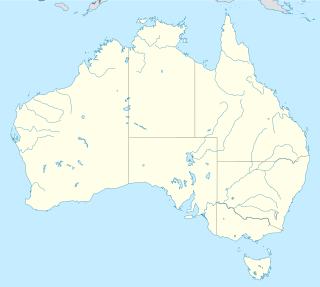Many Australian Aboriginal cultures have or traditionally had a manually coded language, a signed counterpart of their oral language. This appears to be connected with various speech taboos between certain kin or at particular times, such as during a mourning period for women or during initiation ceremonies for men, as was also the case with Caucasian Sign Language but not Plains Indian Sign Language, which did not involve speech taboo, or deaf sign languages, which are not encodings of oral language. There is some similarity between neighboring groups and some contact pidgin similar to Plains Indian Sign Language in the American Great Plains.
Badimaya is an Australian Aboriginal language. It is a member of the Kartu subgroup of the Pama–Nyungan family.

Gaagudju is an extinct Australian Aboriginal language formerly spoken in Arnhem Land in northern Australia, in the environs of Kakadu National Park. Its last speaker, Big Bill Neidjie, died on 23 May 2002.
Garawa is an Australian Aboriginal language spoken by the Garrwa people of northern Australia.

Maningrida, also known as Burarran, is a small family of Australian Aboriginal languages spoken in northern Australia. It includes four languages, none closely related:

Giimbiyu is an extinct Aboriginal Australian language isolate once spoken by the Giimbiyu people of northern Australia.
Kunwinjku, also known by the cover term Bininj Gunwok or Mayali, is an Australian Aboriginal language in northern Australia. The Bininj Gun-Wok peoples live primarily in western Arnhem Land. There are perhaps two thousand fluent speakers in an area roughly bounded by Kakadu National Park to the west, the Arafura Sea to the north, the Blyth River to the east, and the Katherine region to the south.
Kuku-Thaypan is an extinct Paman language spoken on the southwestern part of the Cape York Peninsula, Queensland in Australia, by the Kuku-Thaypan people. The language was sometimes called Alaya or Awu Alaya. Koko-Rarmul may have been a dialect, though Bowern (2012) lists Gugu-Rarmul and Kuku-Thaypan as separate languages. The last native speaker, Tommy George, died 29 July 2016 in Cooktown Hospital.

Dalabon is a Gunwinyguan language of Arnhem Land, Australia. It is a severely endangered language, with perhaps as few as three fluent speakers remaining as of 2018. Dalabon is also known as Dangbon, Ngalkbun, and Buwan.
Ndjébbana, also known as Djeebbana, Kunibidji, Gunavidji, Gunivugi, or Gombudj, is a Burarran language spoken by the Kunibidji people of North-central Arnhem Land, Australia.
Jawoyn, or Kumertuo, is an endangered Gunwinyguan language spoken by elders in Arnhem Land, Australia.
Gunbarlang (Kunbarlang) is an Australian Aboriginal language in northern Australia with multiple dialects. Other names are Gungalang and Warlang. Speakers are multilingual in Gunwinygu and Mawng. Most of the Gunbarlang people now speak Gunwinygu.
Alawa (Galawa) is a moribund Indigenous Australian language spoken by the Alawa people of the Northern Territory. In 1991, it had 18 remaining speakers and 4 semi-speakers.
Rembarrnga (Rembarunga) is an Australian Aboriginal language. It is one of the Northern Non-Pama–Nyungan languages, spoken in the Roper River region of the Northern territory. There are three dialects of Rembarrnga, namely Galduyh, Gikkik and Mappurn. It is a highly endangered language, with very few remaining fluent speakers. It is very likely that the language is no longer being learned by children. Instead, the children of Rembarrnga speakers are now learning neighbouring languages such as Kriol in south central Arnhem Land, and Kunwinjku, a dialect of Bininj Gunwok, in north central Arnhem Land.
Djinang is an Australian Aboriginal Yolŋu language, spoken in Australia's Northern Territory.
Djinba is an Australian Aboriginal Yolŋu language, spoken by the Djinba in eastern Arnhem Land, Northern Territory.
Uwinymil is an Australian Aboriginal language spoken of Arnhem Land.

The Macro-Gunwinyguan languages, also called Arnhem or Gunwinyguan, are a family of Australian Aboriginal languages spoken across eastern Arnhem Land in northern Australia. Their relationship has been demonstrated through shared morphology in their verbal inflections.
The Gungorogone are an indigenous Australian people of the Northern Territory.





